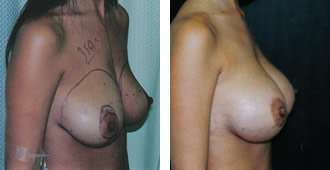BEVERLY HILLS BREAST LIFT WITH IMPLANT
Posted On: February 07, 2012 Author: The Office of Dr. Stuart Linder Posted In: Breast Augmentation, Breast Implants, Breast Lift, Breast topics, Plastic Surgery
Patients present to us weekly with needs, including breast augmentation and breast lifts. At times they need combination procedures and at times we will only perform one or the other and stage the second surgery. When a patient arrives in consultation, it is absolutely vital that the Board Certified Plastic Surgeon clinically judge, measure the inframammary folds and determine the position of the nipple areolar complex and its relationship to the fold to determine what type of breast lift, if any, is required as well as what type of implant if augmentation will be performed either concurrently or at a separate stage.
Peri-Areolar Lift
Indications for combination breast lifts and augmentation include patients who have grade 3 ptosis where the nipple is well below the inframammary fold, often 3 cm or greater and they have loss of breast volume referred to often as involutional upper pole atrophy or bilateral breast hypoplasia. These patients do well with combination augmentation mammoplasty either with silicone or saline implants, depending upon thickness of tissue and desires of the patient, placed in the dual plane technique as well as a breast lift which usually is an inferior pedicle Wise-pattern formal mastopexy referred to as the anchor scar. Once it has been determined that a patient requires a combination augmentation mammoplasty and mastopexy, we will determine the amount of breast tissue available. If the tissue is minimal and the patient has very little volume, then I usually will perform the combination implants subpectorally or in the dual plane combined with a formal mastopexy or a vertical lift, depending upon degree of sagginess or laxity of the skin, as well as the degree of position of the nipple areolar complex to the fold. Patients who present with a larger amount of breast tissue, a C or D, also will undergo formal mastopexy first, and if then desire to go larger can be staged and have an implant placed several months later once the healing from the lift has taken place. We prefer to wait at least three to four months postoperatively before placing the implants subpectorally.
The risks of combination breast augmentation with breast lifting are controversial. In general, doctors who are experienced, have excellent judgment and are Board Certified with the American Board of Plastic Surgery who specialize in breast augmentation, breast lift, breast revision surgery are able to capably successfully combine augmentation implants behind the muscle and not jeopardize the nipple areolar complex blood supply by removing skin. In general, skin dissection and undermining around the nipple areolar complex must be conservative only when performing a combination augmentation and a breast lift procedure. We perform lifts with implants concurrently on patients all the time and have been successful uniformly.
In general, patients who have had implants placed in the past who have very thinned out tissue may be at higher risk for skin death, necrosis or avascular necrosis of the nipple areolar complex when performing augmentation with a formal mastopexy via secondary surgery. The reason is the blood supply may already be somewhat jeopardized from the original surgery and performing implants and a lift with a very thinned out blood supply may certainly increase risk of death to the nipple areolar complex or skin loss. Therefore, once again only the most experienced Board Certified Plastic Surgeon should be doing secondary revisions with removal, replacement, and capsulotomies with concurrent formal mastopexies.
The risks of breast lift augmentations combine also will include, as usual, significant scarring, which can include keloid, hypertrophic scarring, hypo or hyperpigmentation and widespread scarring. Avascular necrosis of the nipple areolar complex can certainly occur. Hemorrhage or hematomas can occur with the subpectoral or removal and replacement and once again any time the implant is exposed to the outside world, infection is certainly a possibility including staphylococcus aureus, streptococcus, Pseudomonas, E. coli, and other forms of gram positive and gram negative infections.
